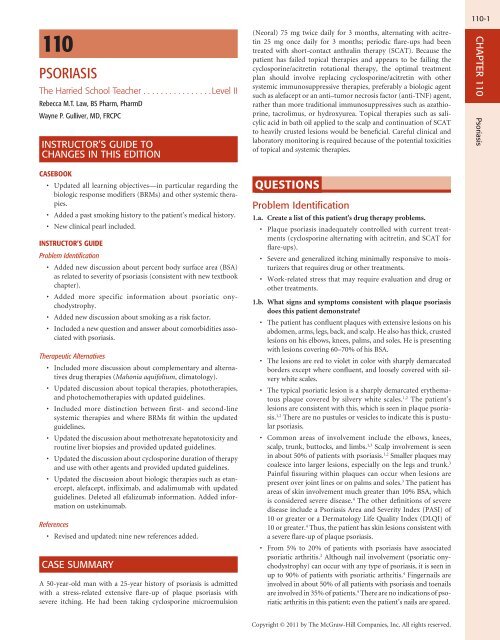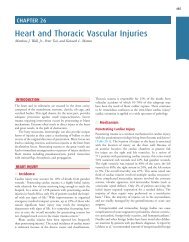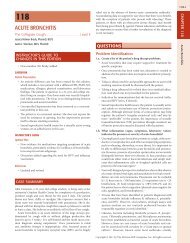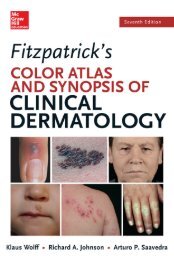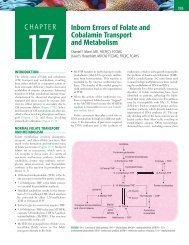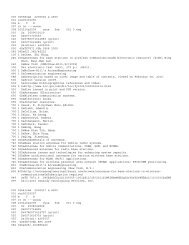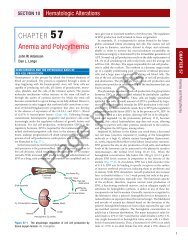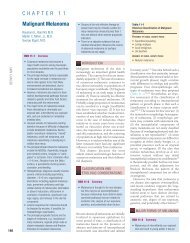PSORIASIS - McGraw-Hill Professional
PSORIASIS - McGraw-Hill Professional
PSORIASIS - McGraw-Hill Professional
Create successful ePaper yourself
Turn your PDF publications into a flip-book with our unique Google optimized e-Paper software.
110<br />
<strong>PSORIASIS</strong><br />
The Harried School Teacher Level II<br />
Rebecca M.T. Law, BS Pharm, PharmD<br />
Wayne P. Gulliver, MD, FRCPC<br />
INSTRUCTOR’S GUIDE TO<br />
CHANGES IN THIS EDITION<br />
(Neoral) 75 mg twice daily for 3 months, alternating with acitretin<br />
25 mg once daily for 3 months; periodic flare-ups had been<br />
treated with short-contact anthralin therapy (SCAT). Because the<br />
patient has failed topical therapies and appears to be failing the<br />
cyclosporine/acitretin rotational therapy, the optimal treatment<br />
plan should involve replacing cyclosporine/acitretin with other<br />
systemic immunosuppressive therapies, preferably a biologic agent<br />
such as alefacept or an anti–tumor necrosis factor (anti-TNF) agent,<br />
rather than more traditional immunosuppressives such as azathioprine,<br />
tacrolimus, or hydroxyurea. Topical therapies such as salicylic<br />
acid in bath oil applied to the scalp and continuation of SCAT<br />
to heavily crusted lesions would be beneficial. Careful clinical and<br />
laboratory monitoring is required because of the potential toxicities<br />
of topical and systemic therapies.<br />
110-1<br />
CHAPTER 110<br />
Psoriasis<br />
CASEBOOK<br />
• Updated all learning objectives—in particular regarding the<br />
biologic response modifiers (BRMs) and other systemic therapies.<br />
• Added a past smoking history to the patient’s medical history.<br />
• New clinical pearl included.<br />
INSTRUCTOR’S GUIDE<br />
Problem Identification<br />
• Added new discussion about percent body surface area (BSA)<br />
as related to severity of psoriasis (consistent with new textbook<br />
chapter).<br />
• Added more specific information about psoriatic onychodystrophy.<br />
• Added new discussion about smoking as a risk factor.<br />
• Included a new question and answer about comorbidities associated<br />
with psoriasis.<br />
Therapeutic Alternatives<br />
• Included more discussion about complementary and alternatives<br />
drug therapies (Mahonia aquifolium, climatology).<br />
• Updated discussion about topical therapies, phototherapies,<br />
and photochemotherapies with updated guidelines.<br />
• Included more distinction between first- and second-line<br />
systemic therapies and where BRMs fit within the updated<br />
guidelines.<br />
• Updated the discussion about methotrexate hepatotoxicity and<br />
routine liver biopsies and provided updated guidelines.<br />
• Updated the discussion about cyclosporine duration of therapy<br />
and use with other agents and provided updated guidelines.<br />
• Updated the discussion about biologic therapies such as etanercept,<br />
alefacept, infliximab, and adalimumab with updated<br />
guidelines. Deleted all efalizumab information. Added information<br />
on ustekinumab.<br />
References<br />
• Revised and updated; nine new references added.<br />
CASE SUMMARY<br />
A 50-year-old man with a 25-year history of psoriasis is admitted<br />
with a stress-related extensive flare-up of plaque psoriasis with<br />
severe itching. He had been taking cyclosporine microemulsion<br />
QUESTIONS<br />
Problem Identification<br />
1.a. Create a list of this patient’s drug therapy problems.<br />
• Plaque psoriasis inadequately controlled with current treatments<br />
(cyclosporine alternating with acitretin, and SCAT for<br />
flare-ups).<br />
• Severe and generalized itching minimally responsive to moisturizers<br />
that requires drug or other treatments.<br />
• Work-related stress that may require evaluation and drug or<br />
other treatments.<br />
1.b. What signs and symptoms consistent with plaque psoriasis<br />
does this patient demonstrate?<br />
• The patient has confluent plaques with extensive lesions on his<br />
abdomen, arms, legs, back, and scalp. He also has thick, crusted<br />
lesions on his elbows, knees, palms, and soles. He is presenting<br />
with lesions covering 60–70% of his BSA.<br />
• The lesions are red to violet in color with sharply demarcated<br />
borders except where confluent, and loosely covered with silvery<br />
white scales.<br />
• The typical psoriatic lesion is a sharply demarcated erythematous<br />
plaque covered by silvery white scales. 1,2 The patient’s<br />
lesions are consistent with this, which is seen in plaque psoriasis.<br />
1,2 There are no pustules or vesicles to indicate this is pustular<br />
psoriasis.<br />
• Common areas of involvement include the elbows, knees,<br />
scalp, trunk, buttocks, and limbs. 1,3 Scalp involvement is seen<br />
in about 50% of patients with psoriasis. 1,2 Smaller plaques may<br />
coalesce into larger lesions, especially on the legs and trunk. 3<br />
Painful fissuring within plaques can occur when lesions are<br />
present over joint lines or on palms and soles. 3 The patient has<br />
areas of skin involvement much greater than 10% BSA, which<br />
is considered severe disease. 4 The other definitions of severe<br />
disease include a Psoriasis Area and Severity Index (PASI) of<br />
10 or greater or a Dermatology Life Quality Index (DLQI) of<br />
10 or greater. 4 Thus, the patient has skin lesions consistent with<br />
a severe flare-up of plaque psoriasis.<br />
• From 5% to 20% of patients with psoriasis have associated<br />
psoriatic arthritis. 2 Although nail involvement (psoriatic onychodystrophy)<br />
can occur with any type of psoriasis, it is seen in<br />
up to 90% of patients with psoriatic arthritis. 4 Fingernails are<br />
involved in about 50% of all patients with psoriasis and toenails<br />
are involved in 35% of patients. 4 There are no indications of psoriatic<br />
arthritis in this patient; even the patient’s nails are spared.<br />
Copyright © 2011 by The <strong>McGraw</strong>-<strong>Hill</strong> Companies, Inc. All rights reserved.
110-2<br />
SECTION 14 Dermatologic Disorders<br />
• There are excoriations on the trunk and extremities resulting<br />
from severe itching and scratching related to psoriasis.<br />
1.c. What risk factors for developing psoriasis or experiencing a<br />
disease flare-up are present in this patient?<br />
Risk factors for developing psoriasis:<br />
• There is relevant family history: His younger brother also has<br />
psoriasis. Psoriasis and psoriatic arthritis have complex genetic<br />
associations and generally result from an interplay between<br />
multiple genetic and environmental factors. There is a polygenic<br />
inheritance pattern. 5 There are psoriasis susceptibility<br />
genes and variants that reside on various chromosomes. The<br />
psoriasis susceptibility 1 (PSORS1) gene on chromosome 6 is<br />
considered the most important susceptibility locus and is associated<br />
with up to 50% of cases of psoriasis. 2 Other chromosomes<br />
with psoriasis susceptibility loci include 1p (PSORS7),<br />
1q21 (PSORS4), 3q21 (PSORS5), 4q34 (PSORS3), 7p, 8, 11,<br />
16q, 17q25 (PSORS2), 19p13 (PSORS6), and 20p, and others<br />
are being found. 1,2,5 For patients with known genetic-linked<br />
psoriasis, there is a strong tendency that the disease onset<br />
occurs in early adulthood. 4<br />
• Twin studies have shown a 3-fold increased risk of psoriasis in<br />
monozygotic twins versus fraternal twins, with environmental<br />
factors also playing a role. 1,2,5 In addition, based on a study<br />
of 3,095 families with psoriasis, the calculated lifetime risk of<br />
developing psoriasis if no parent, one parent, or both parents<br />
have psoriasis was found to be 0.04, 0.28, and 0.65, respectively.<br />
If there was already one affected child in the family, the risks<br />
were increased to 0.24, 0.51, and 0.83, respectively. 1,2 Gene<br />
identification and linkage studies are ongoing.<br />
• Smoking cigarettes has recently been shown in two international<br />
studies to be a risk factor for psoriasis. 4 The patient is an<br />
ex-smoker who used to smoke heavily in his 20s and 30s. He<br />
was diagnosed with plaque psoriasis at age 23. There is also an<br />
increased prevalence of smoking associated with patients with<br />
psoriasis, seen in numerous countries. 4<br />
Risk factors for experiencing a psoriasis flare:<br />
• The patient complains of feeling jumpy and appears to be under<br />
some stress in his work with the school board. The increasing<br />
stress could explain the frequent flare-ups of his psoriasis in<br />
the past year.<br />
• Although physical trauma or infections (particularly streptococcal<br />
upper respiratory tract infections) may trigger an exacerbation<br />
of psoriasis, 1,2 there are no indications of these in the<br />
patient.<br />
1.d. What comorbidities does this patient have?<br />
• Comorbidities associated with psoriasis may be medical or<br />
psychiatric/psychological. Medical comorbidities include<br />
hypertension, hypertriglyceridemia, impaired glucose regulation,<br />
and obesity; autoimmune diseases such as psoriatic<br />
arthritis, Crohn’s disease, and multiple sclerosis; and malignancies<br />
such as cutaneous T-cell lymphoma. 4 Psychiatric/<br />
psychological comorbidities include depression/suicidal<br />
ideation and suicide, anxiety, and poor self-esteem. 4 This<br />
patient is undergoing some stress and anxiety. He has a positive<br />
family history for cardiovascular disorders: a father with<br />
hypertension and type 2 diabetes. Thus, it would be prudent<br />
to routinely screen this patient for the above medical and<br />
psychiatric/psychological comorbidities. The importance of<br />
screening for comorbidities in psoriatic patients cannot be<br />
overemphasized.<br />
1.e. Could the signs and symptoms be caused by any drug therapy<br />
he is receiving?<br />
• He is not receiving any drugs known to precipitate psoriasis<br />
(e.g., lithium, β-blockers, indomethacin, antimalarials such as<br />
chloroquine, and fluoxetine). Molecular mechanisms for druginduced<br />
flares of psoriasis are not completely understood. It<br />
is thought that lithium may elevate proinflammatory cytokines,<br />
thereby stimulating cutaneous leukocyte recruitment.<br />
β-Blockers may induce epidermal hyperproliferation associated<br />
with a decrease in intraepidermal cyclic adenosine monophosphate.<br />
Chloroquine blocks epidermal transglutaminase,<br />
involved in the terminal differentiation of keratinocytes. 1<br />
• Withdrawal of corticosteroids after prolonged use and hypocalcemia<br />
may also exacerbate psoriasis; neither of these is a cause<br />
in this patient.<br />
Desired Outcome<br />
2. What are the goals of pharmacotherapy for this patient’s<br />
plaque psoriasis?<br />
• Eliminate plaquelike skin lesions and achieve remission if<br />
possible.<br />
• Relieve the severe itching accompanying the psoriasis flare-up.<br />
• Prevent future flare-ups (relapses) of the psoriasis.<br />
• Relieve his work-related stress through nonpharmacologic<br />
and/or pharmacologic means.<br />
• Minimize drug-related toxicity and ensure no significant drug<br />
interactions with current medications.<br />
Therapeutic Alternatives<br />
3.a. What nonpharmacologic alternatives are available for managing<br />
the patient’s psoriasis and its related symptoms?<br />
• Stress reduction (e.g., psychotherapy that includes stress management,<br />
guided imagery, and relaxation techniques) has been<br />
shown to improve the extent and severity of psoriasis.<br />
• Oatmeal baths such as Aveeno Oilated in tepid water may<br />
help soothe the itching with less need for systemic antipruritic<br />
agents.<br />
• Nonmedicated moisturizers used liberally several times daily may<br />
help prevent skin dryness. Maintaining adequate skin moisture<br />
helps control the scaling associated with psoriasis. Fragrancefree<br />
products should be selected when available. 1<br />
• Avoid irritant chemicals on the skin (e.g., harsh soaps or detergents).<br />
Cleansing should be done preferably with lipid- and<br />
fragrance-free cleansers, using tepid water.<br />
• Avoid skin trauma. Sunburns can induce a flare-up of psoriasis;<br />
thus, sunscreens with a sun protection factor of at least<br />
15 (preferably a sun protection factor of 30 or higher) should<br />
be routinely applied when outdoors. 1<br />
• Climatotherapy is a complementary and alternative medicine<br />
(CAM) treatment for psoriasis that involves bathing in the<br />
Dead Sea, or using Dead Sea salts (DSS) or saline spa water<br />
combined with phototherapy (see discussion below). Limited<br />
studies using DSS or saline spa water appeared efficacious. 6<br />
3.b. What feasible pharmacotherapeutic alternatives are available<br />
for controlling the patient’s disease and its related symptoms<br />
at this point?<br />
• Pharmacotherapy for plaque psoriasis consists of topical treatments,<br />
phototherapy, photochemotherapy, and systemic therapies.<br />
Between 2008 and 2010, both the American Academy<br />
Copyright © 2011 by The <strong>McGraw</strong>-<strong>Hill</strong> Companies, Inc. All rights reserved.
110-3<br />
of Dermatology (AAD) and the Canadian Dermatology<br />
Association (CDA) updated their treatment guidelines for<br />
psoriasis. The AAD guidelines were published in five sections,<br />
whereas the CDA published an entire guideline book. 3,4,7–9 In<br />
addition, the National Psoriasis Foundation held consensus<br />
conferences and published updated guidelines for use of methotrexate<br />
and cyclosporine. 10,11<br />
• Topical treatments are most effective for mild to moderate or<br />
limited disease, or used as adjunct for extensive disease 4,7 and<br />
include the following options:<br />
✓ ✓ Corticosteroids are available in a variety of potencies,<br />
strengths, and vehicles; selection depends on disease severity<br />
and lesion location. Low-potency agents (e.g., hydrocortisone)<br />
are used on the face and skin folds, and very-highpotency<br />
agents (e.g., clobetasol propionate) are generally<br />
reserved for thickly hyperkeratotic areas such as palms and<br />
soles. Refer to the textbook chapter for a table comparing<br />
corticosteroid potencies. Topical corticosteroids may<br />
cause topical side effects such as striae, skin atrophy, acne,<br />
telangiectasia, and rosacea. Systemic side effects from topical<br />
corticosteroids can also occur, including hypothalamic–<br />
pituitary–adrenal axis (HPA) suppression, hyperglycemia,<br />
and glaucoma. Tachyphylaxis can occur after prolonged use,<br />
and sensitization can develop. 1,4,7<br />
✓ ✓ Calcipotriol is a vitamin D 3<br />
analogue that inhibits keratinocyte<br />
proliferation and promotes normal keratinization. It<br />
may cause hypercalcemia secondary to excessive absorption<br />
or use, or if underlying renal disease or impaired calcium<br />
metabolism exists. 4,7 It can be combined with ultraviolet B<br />
(UVB) phototherapy but is inactivated by UVA. 7<br />
✓ ✓ Calcipotriol plus betamethasone dipropionate is available in<br />
some countries (e.g., Canada) as a combination product<br />
(Dovobet). Dovobet ointment is effective for psoriasis when<br />
applied once daily in combination with thrice-weekly UVB<br />
therapy. 4<br />
✓ ✓ Tazarotene (0.05% or 0.1% gel) is a retinoid with antiinflammatory<br />
and antiproliferative effects. 4,7 It may cause<br />
skin irritation especially initially; concomitant use of products<br />
with a strong drying effect, whether topical preparations<br />
or cosmetics, should be avoided when possible. It can<br />
be used with phototherapy for enhanced effect. 4,7<br />
✓ ✓ Anthralin including SCAT with high anthralin concentrations<br />
(2–4%) for 20 minutes to 2 hours daily is effective,<br />
especially on thicker plaques, but may be highly irritating,<br />
especially if SCAT treatments are misused. 1 It is not as commonly<br />
used as the topical agents discussed previously. It can<br />
be used with phototherapy for enhanced effect. 4,7<br />
✓ ✓ Crude coal tar (liquor carbonis detergens) in various preparations<br />
is also not as commonly used today. It is keratolytic and<br />
may have antiproliferative and anti-inflammatory effects. 1,7<br />
It may have similar efficacy as calcipotriol but has a slower<br />
onset. These preparations may precipitate folliculitis, as well<br />
as being cosmetically unappealing and may stain clothing. It<br />
can be used with phototherapy for enhanced effect. 4,7<br />
✓ ✓ Keratolytic agents such as salicylic acid are often added to<br />
bath oil or shampoos for scalp psoriasis. 1,7<br />
✓ ✓ M. aquifolium 10% topical cream or lotion (Relieva) is a<br />
topical herbal product standardized to contain 10% berberine,<br />
which may have limited potency for psoriasis. It<br />
inhibits keratinocyte growth and reduces keratinocyte proliferation<br />
and may be beneficial to some patients. 6 However,<br />
clinical trials are still limited, and there is a paucity of pharmacokinetic<br />
information such as systemic absorption data.<br />
In animal studies, berberine has uterine-contracting actions<br />
and anticonvulsant activity, and may depress cardiac function<br />
and respiration.<br />
✓ ✓ Vehicles play a role in absorption and hence affect drug<br />
potency. A drug in an ointment base is more potent than<br />
in a cream base since ointments are occlusive and increase<br />
skin hydration. 1 Refer to the corticosteroid potency table in<br />
the textbook for some examples of potency changes due to<br />
different vehicles used.<br />
• Phototherapy and photochemotherapy are used for moderate<br />
to severe psoriasis, or when a patient fails topical therapy.<br />
Photochemotherapy is the concurrent use of phototherapy<br />
together with topical or systemic agents. 1,9 Phototherapy uses<br />
either UVB or UVA. UVB treatment modalities include broadband<br />
UVB or narrowband UVB (NB-UVB) used alone, or UVB<br />
with topical crude coal tar (Goeckerman regimen), UVB with<br />
topical anthralin (Ingram technique), NB-UVB with oral retinoids<br />
such as acitretin (RE-UVB), or UVB with methotrexate.<br />
UVA treatment modalities include UVA with oral or bath psoralens<br />
(psoralens with UVA phototherapy [PUVA]) used alone,<br />
or PUVA with oral retinoids (RE-PUVA), and PUVA with calcipotriol.<br />
1,9 There may be an increased risk of skin cancers after<br />
prolonged use of phototherapy or photochemotherapy, and<br />
their use is contraindicated in patients with a history of melanoma<br />
or multiple nonmelanoma skin cancers. Carcinogenic<br />
risks are significantly greater with PUVA than UVB. In addition,<br />
there are other contraindications associated with either<br />
UVB or PUVA therapy. 9 Targeted phototherapy using excimer<br />
lasers that selectively target psoriatic lesions without affecting<br />
normal skin is an option being studied and early results appear<br />
promising, although blistering and burning of treated lesions<br />
are more common, and long-term safety has not been established.<br />
9<br />
• Traditional systemic therapies are seldom used for mild to<br />
moderate psoriasis and are generally reserved for patients with<br />
moderate to severe psoriasis. 1,4,7 However, a subset of patients<br />
with limited disease but debilitating symptoms may benefit<br />
from systemic treatment. First-line systemic therapies include<br />
methotrexate, acitretin, and cyclosporine. Although systemic<br />
therapies may be optimally used in a rotating fashion to minimize<br />
drug toxicities in patients requiring long-term systemic<br />
treatments, this is not routine practice for most dermatologists.<br />
However, rotational therapy to minimize cyclosporine toxicity<br />
(e.g., methotrexate → cyclosporine or methotrexate → acitretin<br />
→ cyclosporine) may be helpful 10 as the appropriate duration<br />
of use for cyclosporine is not established. Current guidelines<br />
recommend either intermittent use in periods up to 12 weeks 4<br />
to minimize nephrotoxicity 7 or continuous use up to 2 years. 10<br />
✓ ✓ Methotrexate (variable dosage range of 2.5–25.0 mg once<br />
per week) is generally considered the gold standard for<br />
traditional systemic therapies. 11 The combination of methotrexate<br />
and UVB appears to be synergistic. 1,9,11 Methotrexate<br />
carries a risk of hepatotoxicity, which is more significant in<br />
patients with other coexisting conditions: type 2 diabetes,<br />
alcoholism, obesity, and preexisting hepatic dysfunction. 11<br />
Monitoring for psoriatic patients on long-term methotrexate<br />
use has traditionally included regular liver biopsies; however,<br />
the risks and benefits were recently reevaluated, and<br />
there is some evidence that this may not be routinely necessary<br />
for all patients. 11 Recent studies also seem to indicate<br />
that methotrexate-induced hepatic fibrosis and cirrhosis<br />
are rarer than initially reported. 11 Current AAD guidelines<br />
recommend the following: for low-risk patients, no baseline<br />
CHAPTER 110<br />
Psoriasis<br />
Copyright © 2011 by The <strong>McGraw</strong>-<strong>Hill</strong> Companies, Inc. All rights reserved.
110-4<br />
SECTION 14 Dermatologic Disorders<br />
liver biopsy, and consider liver biopsy after 3.5–4 g total<br />
cumulative dosage or consider switching to another agent;<br />
for high-risk patients, consider using another systemic agent<br />
altogether, or consider delayed baseline liver biopsy (after<br />
2–6 months of therapy to establish medication efficacy and<br />
tolerability), and repeat liver biopsies after approximately<br />
1–1.5 g of therapy. 11 Besides regular liver function tests<br />
(monthly for the first 6 months and then every 1–2 months),<br />
periodic complete blood counts (CBCs), renal function<br />
tests, and pulmonary toxicity tests should also be conducted.<br />
Pancytopenia is rare with doses used in psoriasis; however,<br />
it may still occur at any time during treatment, particularly<br />
in those with preexisting hematologic risk factors. Routine<br />
folic acid supplementation has been recommended to<br />
minimize hepatotoxicity, but this is currently controversial<br />
due to some evidence of slightly reduced efficacy of the<br />
methotrexate. 11 Some dermatologists would wait until signs<br />
of hematologic toxicity are seen before giving folate. There<br />
is also a risk of malignancy with methotrexate.<br />
✓ ✓ Acitretin is the free acid active metabolite of etretinate and<br />
is more potent when used with UVB or PUVA. It may produce<br />
a more rapid initial response than methotrexate for<br />
patients with severe inflammatory forms of psoriasis, and it<br />
has antineoplastic properties. The initial dose is 25–50 mg<br />
per day. Benefits should be visible within 10 days of drug<br />
initiation. Although not a problem in this case, acitretin<br />
is teratogenic and relatively contraindicated in women of<br />
childbearing potential. It must not be used in pregnant<br />
women, those with unreliable contraception, or those who<br />
intend to become pregnant at any time during or for 3 years<br />
after discontinuation of therapy. 8 Men should not donate<br />
blood for a similar time period. Ethanol should be avoided<br />
during therapy and for 2 months after drug discontinuation<br />
since it causes the transesterification of acitretin to etretinate,<br />
which has a much longer elimination half-life. Other<br />
side effects include ophthalmologic, neuromuscular, and<br />
hyperlipidemic changes. 1,8<br />
✓ ✓ Cyclosporine is a valuable option for management of psoriasis,<br />
but due to significant toxicities it is often reserved for<br />
treatment failures, in crisis management, and as a bridge<br />
to other therapies. 10 The combination of cyclosporine and<br />
calcipotriol may be more efficacious than either agent<br />
used alone. 1,10 Cyclosporine may also be successfully used<br />
with SCAT; however, it should not be used with PUVA<br />
due to reduced efficacy and the potential increased risk<br />
of cutaneous malignancies. 10 The risk of nephrotoxicity is<br />
higher in psoriatic patients than renal transplant recipients;<br />
drug-induced hypertension and possible carcinogenesis are<br />
also of concern. Intermittent cyclosporine used in 12-week<br />
cycles with other systemic agents such as a retinoid is useful<br />
in prolonging the disease-free period and in minimizing<br />
drug toxicities. The microemulsion formulation is more<br />
effective and is the recommended formulation. For patients<br />
with stable generalized psoriasis or when the severity of<br />
disease is moderate to severe, the recommended starting<br />
dose is 2.5 mg/kg per day given orally in two divided doses.<br />
Wait at least 4 weeks before considering increasing the dosage<br />
by 0.5 mg/kg per day every 2 weeks if the response is<br />
inadequate, to 4 mg/kg per day. 10 There may be patients<br />
who require more than 4 mg/kg per day for clearance, and a<br />
maximum dose of 6 mg/kg per day is recommended. 10<br />
For patients with severe inflammatory flares of psoriasis<br />
or recalcitrant cases who have failed to respond to numerous<br />
other therapies, or for a highly distressed patient in a crisis<br />
situation, the recommended starting dose is 4–6 mg/kg per<br />
day, to be decreased by 0.5–1.0 mg/kg per day at weekly or<br />
longer periods once the patient has a clear response, to the<br />
lowest effective maintenance dose.<br />
As mentioned earlier, optimal duration of therapy for<br />
cyclosporine in the treatment of plaque psoriasis has not<br />
been established. Intermittent short-course (75% in psoriasis severity, consistently over at least three<br />
treatment cycles. 4 When transitioning from cyclosporine<br />
to other systemic therapies, there should be an overlap<br />
period to allow tapering of the cyclosporine dosage.<br />
If transitioning to a biologic agent, the overlap period<br />
should be minimal to reduce the risk of opportunistic<br />
infections. 10 The National Psoriasis Foundation recommends<br />
the cyclosporine treatment duration be limited to<br />
2 years or less, and that in those patients on continuous<br />
therapy for longer than 1 year, a nephrologist be involved<br />
to assist with management of cyclosporine-associated<br />
nephrotoxicity. 10<br />
Blood pressure, serum creatinine, blood urea nitrogen,<br />
CBC, uric acid, potassium, magnesium, and lipids should<br />
be assessed prior to beginning therapy to obtain accurate<br />
baseline values, and reassessed biweekly once therapy is<br />
started for the first 12 weeks of therapy and then monthly<br />
during therapy. 10 If the serum creatinine increases to 25%<br />
above the patient’s baseline on two occasions (2 weeks<br />
apart), the cyclosporine dosage needs to be decreased by<br />
25–50% and serum creatinine rechecked as often as every<br />
other week for 1 month. If the serum creatinine does not<br />
return to within 10% of the patient’s baseline value, a further<br />
dose decrease of 25–50% should be considered. If the<br />
value continues to be greater than 10% above the patient’s<br />
baseline value, consider discontinuing cyclosporine therapy.<br />
10 (Note: A 25% above-baseline cutoff for dosage reduction<br />
is the manufacturer’s recommendation; the National<br />
Psoriasis Foundation consensus guidelines continue to<br />
recommend a 30% cutoff. 10 ) Cyclosporine should be discontinued<br />
if there is insufficient response after 3 months at<br />
the maximum dose. 1<br />
✓ ✓ Sulfasalazine has variable efficacy and is of limited potency,<br />
and psoriasis is not an approved indication for its use.<br />
However, its side-effect profile is better than other systemic<br />
therapies; side effects are common but generally not serious.<br />
Usual doses are 2–4 g per day in divided doses. 1,8<br />
✓ ✓ Azathioprine has been used in doses of 50 mg twice daily.<br />
However, the response time is slower than methotrexate or<br />
cyclosporine.<br />
✓ ✓ Tacrolimus (FK506) is an immunosuppressive agent used<br />
to prevent organ transplant rejection that has shown dramatic<br />
effectiveness for patients with psoriasis. However, side<br />
effects including nephrotoxicity, hypertension, GI intolerance,<br />
paresthesias, tremor, and palpitations have limited<br />
its use.<br />
✓ ✓ Hydroxyurea (500 mg twice daily) is an option in patients<br />
who have contraindications to methotrexate because of liver<br />
disease. However, there have been recent precautions about<br />
Copyright © 2011 by The <strong>McGraw</strong>-<strong>Hill</strong> Companies, Inc. All rights reserved.
110-5<br />
its use in the elderly and cutaneous vasculitic toxicities in<br />
patients with myeloproliferative disorders. 1<br />
✓ ✓ Mycophenolate mofetil is not approved for psoriasis; however,<br />
it has been used effectively for recalcitrant moderate to<br />
severe psoriasis in limited studies. 1,8<br />
✓ ✓ Oral corticosteroids are reserved for severe or life-threatening<br />
conditions such as severe psoriatic arthritis or exfoliative<br />
psoriasis; prolonged steroid use should be avoided.<br />
• Biologic agents alefacept, etanercept, adalimumab, infliximab,<br />
ustekinumab, and others are becoming incorporated into the<br />
same category as other systemic agents and are currently recommended<br />
for consideration as first-line therapies alongside<br />
conventional systemic agents for moderate to severe disease. 3,4<br />
In particular, they would be an appropriate first-line choice if<br />
comorbidities such as psoriatic arthritis are present. However,<br />
due to the significant cost difference, these agents are generally<br />
reserved for cases where traditional systemic agents are inadequate<br />
or if comorbidities exist. 1,3,4 Biologic agents employ<br />
various targeted immunosuppressive strategies: alefacept targets<br />
memory T cells; etanercept, infliximab, and adalimumab<br />
target TNF-α; and ustekinumab selectively targets IL-12 and<br />
IL-23. In general, due to their immunosuppressive effects,<br />
there is a significantly increased risk of infection with most<br />
of these agents, including serious infections such as sepsis,<br />
new-onset or reactivation of tuberculosis (TB), and opportunistic<br />
infections such as histoplasmosis, cryptococcosis,<br />
aspergillosis, candidiasis, and pneumocystis; the use of live<br />
or live-attenuated vaccines during therapy is generally not<br />
recommended. 3,4<br />
✓ ✓ Alefacept (Amevive) is a recombinant fusion protein that<br />
inhibits T-cell activation by binding to their CD2 sites and<br />
also interacts with natural killer cells to destroy already activated<br />
T cells. It was the first biologic agent approved by the<br />
FDA for the treatment of moderate to severe chronic plaque<br />
psoriasis, even in treatment-naive patients. Relative to other<br />
biologics, alefacept monotherapy provides limited control,<br />
but with long periods of complete or incomplete remission<br />
in some cases. 4 About one third of treated patients go into<br />
remissions that are prolonged (6–18 months). The dosage<br />
is 15 mg intramuscular (IM) once weekly for 12 weeks. The<br />
regimen may be repeated in 12 weeks only if needed (up to<br />
two more courses per year) and if the CD4 + T-cell count is<br />
normal (defined as greater than or equal to 250 cells/μL).<br />
Alefacept appears to spare helper T-cell function and does<br />
not significantly impair primary or secondary antibody<br />
responses (to fight infection or respond to vaccinations).<br />
There is a significant risk of malignancy, and common side<br />
effects include lymphopenia, myalgias, chills, pharyngitis,<br />
cough, and nausea, and for IM injections, pain and inflammation<br />
at the injection site. 3,4 Monitoring of the CD4 count<br />
is recommended. 3<br />
✓ ✓ Etanercept (Enbrel) is a fully human dimeric fusion protein<br />
composed of human TNF-α p75 receptor fused to the Fc<br />
portion of human immunoglobulin G1; it acts as a TNF-α<br />
inhibitor. 3 It binds to and inactivates TNF-α, preventing<br />
interactions with its cell surface receptors. It is useful for<br />
chronic moderate to severe plaque psoriasis and for psoriatic<br />
arthritis. The FDA-recommended dose is 50 mg subcutaneously<br />
twice weekly for 12 weeks, followed by 50 mg<br />
subcutaneously once weekly thereafter. Each dose is taken in<br />
two 25-mg injections within a 24-hour period or 3 or 4 days<br />
apart. Etanercept was studied in clinical trials using various<br />
regimens ranging from 50 mg twice weekly to 25 mg once<br />
weekly. In those given 50 mg subcutaneously twice weekly,<br />
49% of patients showed a 75% improvement in the PASI by<br />
12 weeks. 3 The drug was well tolerated, and common side<br />
effects included injection site reactions, headache, increased<br />
respiratory tract infections, and GI symptoms such as nausea.<br />
1 Serious infections (e.g., TB) including fatalities have<br />
been reported with etanercept but are rare when the drug is<br />
used alone. There have also been rare reports of worsening<br />
congestive heart failure (CHF) and new-onset CHF, lupus<br />
without renal or CNS complications, and multiple sclerosis.<br />
3 A small number of patients developed anti-etanercept<br />
antibodies that did not appear to affect drug efficacy. 1<br />
Due to rare reports of blood disorders such as aplastic<br />
anemia, leukopenia, and thrombocytopenia, patients are<br />
advised to contact their doctor if they experience persistent<br />
fever, bruising, bleeding, or paleness. 1,3,4 Among the TNF-α<br />
inhibitors, opportunistic infections are less common with<br />
etanercept than with infliximab or adalimumab 3 ; however, it<br />
is still recommended that patients be evaluated for active or<br />
latent TB prior to therapy and consider yearly PPD. 1,3,4 CBC<br />
and LFTs are also recommended prior to and periodically<br />
during therapy. 3<br />
✓ ✓ Infliximab (Remicade) is a chimeric human/murine monoclonal<br />
antibody against TNF-α. It is a highly effective<br />
treatment on initial exposure, even in severe, acute flares. 4<br />
However, on reinitiation or use beyond the first year of<br />
continuous treatment, efficacy becomes variable. 4 Patients<br />
with moderate to severe plaque psoriasis receive a standard<br />
dosing regimen of three IV infusions (5 mg/kg) over<br />
a 6-week induction period, followed by regular infusions<br />
every 8 weeks. 4 Adverse effects (primarily from experience<br />
in patients with rheumatoid arthritis) have included<br />
infusion reactions, hematologic abnormalities (leukopenia,<br />
neutropenia, thrombocytopenia, and pancytopenia), hepatotoxicity<br />
(rarely: acute liver failure, jaundice, hepatitis, and<br />
cholestasis), hypersensitivity reactions (anaphylaxis, urticaria,<br />
serum sickness), ocular toxicity (optic neuritis and optic<br />
neuropathy), demyelinating disorders, and increased infections<br />
(TB, hepatitis B reactivation, Listeria monocytogenes<br />
infections, fungal infections, sepsis). There is an increased<br />
risk of infections with live vaccines, so this is not recommended<br />
during therapy. Patients should be evaluated for<br />
active or latent TB prior to therapy and consider yearly PPD;<br />
a CBC, LFTs, and hepatitis profile should also be obtained at<br />
baseline and CBC and LFTs monitored periodically during<br />
therapy. 1,3,4<br />
✓ ✓ Adalimumab (Humira) is a TNF-α inhibitor that is a<br />
fully human anti–TNF-α antibody. 3 It binds specifically to<br />
soluble and membrane-bound TNF-α, thus blocking interactions<br />
with p55 and p75 cell surface TNF receptors. 3 It may<br />
also provide rapid control of psoriasis, which appears to<br />
be maintained for at least 1 year with continuous therapy. 4<br />
The dose is 40 mg subcutaneously every 2 weeks given on a<br />
continuous basis. 3 If adalimumab is discontinued, psoriasis<br />
over time will return to pretreatment severity, and there<br />
is loss of efficacy when adalimumab is restarted. 3 Adverse<br />
effects include injection site reactions, exacerbation of heart<br />
failure and new-onset CHF, hematologic abnormalities<br />
(pancytopenia, thrombocytopenia, and leukopenia), multiple<br />
sclerosis, and increased risk of serious infections (especially<br />
respiratory infections such as pneumonia and TB, and<br />
hepatitis B reactivation). Patients should be evaluated for<br />
active or latent TB infection prior to therapy and consider<br />
yearly PPD; a CBC, LFTs, and hepatitis profile should also be<br />
CHAPTER 110<br />
Psoriasis<br />
Copyright © 2011 by The <strong>McGraw</strong>-<strong>Hill</strong> Companies, Inc. All rights reserved.
110-6<br />
SECTION 14 Dermatologic Disorders<br />
obtained at baseline and CBC and LFTs monitored periodically<br />
during therapy. 1,3,4<br />
✓ ✓ Ustekinumab (Stelara) is an IL-12/23 monoclonal antibody<br />
that selectively targets IL-12 and IL-23, two cytokines that<br />
play a role in the pathogenesis of psoriasis. It binds to their<br />
shared p40 protein subunit, thus preventing interaction<br />
with their cell surface IL-12Rβ1 receptor. 12,13 It appears to<br />
provide a rapid response that is sustained for a year with<br />
continuous treatment. It is given subcutaneously at weeks 0<br />
and 4, and then every 12 weeks as maintenance therapy. The<br />
manufacturer recommends dosing by body weight, with<br />
patients weighing 220 lb (100 kg) or less receiving 45 mg<br />
and those weighing more than 220 lb (100 kg) receiving 90<br />
mg. Common side effects include upper respiratory infections,<br />
headache, and tiredness. Serious side effects include<br />
those seen with other BRMs such as serious infections (e.g.,<br />
TB, fungal, viral) and cancer risk; in addition, a reversible<br />
posterior leukoencephalopathy syndrome (RPLS) has been<br />
reported.<br />
• Intralesional corticosteroid injections (triamcinolone acetonide<br />
5–10 mg/mL or triamcinolone hexacetonide 5 mg/mL) may be<br />
useful for small, localized, recalcitrant plaques.<br />
• Antihistamines such as hydroxyzine 10–25 mg po TID and<br />
50–75 mg po at bedtime should be given as adjunctive therapy<br />
to relieve the pruritus. Hydroxyzine also has anxiolytic properties<br />
that may be useful in this patient.<br />
• There are many natural health products/alternative treatments<br />
for psoriasis, including omega-3 fish oil supplements,<br />
cleansing diets, emu oil, lecithin, a protein extract<br />
XP-828L, and Kalawalla (Polypodium leucotomos 50:1<br />
standardized extract). Limited clinical studies with some of<br />
these treatments (e.g., omega-3 fish oil supplements) seem<br />
promising, and there is limited ongoing research. 6 At this time<br />
it is too early to make population-based recommendations<br />
for using these products (see the section “Clinical Course:<br />
Alternative Therapy” for more information about alternative<br />
therapies).<br />
Optimal Plan<br />
4. What drug regimen is best suited for treating this flare-up of<br />
the patient’s psoriasis and its related symptoms?<br />
• The patient has failed topical and photochemotherapies with<br />
the exception of SCAT for defined limited lesions, and his current<br />
regimen of cyclosporine alternating with acitretin appears<br />
to be inadequate. It is important to remember that the patient<br />
is on rotational systemic therapy in combination with topical<br />
and photochemotherapy. Although rotational systemic therapy<br />
is not currently used by most dermatologists, it has been useful<br />
in this case for minimizing cyclosporine toxicity.<br />
• It would be appropriate at this point to consider the use of a<br />
biologic agent, either as monotherapy or in combination with<br />
other therapies. Alefacept, adalimumab, infliximab, etanercept,<br />
and ustekinumab are approved by the US FDA and Health<br />
Canada for plaque psoriasis.<br />
✓✓ Etanercept, infliximab, and adalimumab appear to have a<br />
higher efficacy rate than alefacept. Adalimumab appears to<br />
provide sustained efficacy over at least 1 year, whereas efficacy<br />
becomes variable over time for infliximab.<br />
✓✓ Alefacept, although limited in efficacy, may lead to sustained<br />
complete or incomplete remissions in some patients.<br />
✓✓ Infliximab, although highly efficacious initially even for<br />
severe cases, may lose efficacy if discontinued and reinitiated,<br />
or if used beyond the first year of continuous treatment.<br />
✓✓ Etanercept, adalimumab, or infliximab would be more<br />
convenient to administer than alefacept since patients can<br />
be taught to self-inject the subcutaneous doses, whereas<br />
alefacept therapy would require weekly clinic visits for IM<br />
administration.<br />
✓✓ Three cost–efficacy analyses conducted in 2005, 2007, and<br />
2009 found that the cost–benefit of different biologics is<br />
quite variable. The most recent clinical and economic review<br />
was conducted in 2009 for adalimumab, etanercept, infliximab,<br />
ustekinumab, and efalizumab. 14 This review found<br />
that the cost per responder achieving a PASI 75 response at<br />
12 weeks was lowest for adalimumab and highest for alefacept,<br />
based on the pooled number needed to treat (NNT)<br />
to obtain benefit found at 1.3 (infliximab), 1.5 (ustekinumab<br />
90 mg), 1.6 (adalimumab and ustekinumab 45 mg),<br />
2.3 (etanercept), 4.1 (efalizumab—now off the market in the<br />
United States and Canada), and 5.6 (alefacept). The annual<br />
cost per patient was also lowest for adalimumab, followed<br />
by etanercept, ustekinumab, alefacept (two courses), and<br />
infliximab. This analysis suggests that there are favorable<br />
cost and benefits, particularly with some newer biologics<br />
such as adalimumab being the least expensive and most<br />
cost-effective.<br />
✓✓ With respect to adverse effects, alefacept may be the safest,<br />
but it commonly causes lymphopenia and CD4 counts<br />
must be monitored. The TNF-α inhibitors adalimumab,<br />
etanercept, and infliximab rarely cause hematologic side<br />
effects such as thrombocytopenia but have greater concerns<br />
regarding serious infections including reactivation of TB<br />
and opportunistic infections. Cases of multiple sclerosis<br />
and other central nervous system disorders have also been<br />
observed in association with etanercept and other medications<br />
that target TNF-α, as is the risk of worsening CHF and<br />
new-onset CHF. Infliximab has been associated rarely with<br />
cases of cholecystitis and autoimmune hepatitis, which may<br />
be a class effect for TNF-α inhibitors. None of the agents is<br />
nephrotoxic.<br />
✓✓ Based on the above considerations, adalimumab would be<br />
an appropriate choice for an initial trial of a biologic agent<br />
(as monotherapy) in this patient, due to its efficacy, lower<br />
maintenance cost, and ease of administration.<br />
✓✓ Administer adalimumab 80 mg subcutaneously in the first<br />
week, then 40 mg the following week, and thereafter 40 mg<br />
every other week continuously. 3,4<br />
✓✓ The patient could be taught to self-administer the adalimumab<br />
dose.<br />
• The cyclosporine could be tapered off over 1 month for a<br />
smoother transition.<br />
• If the patient fails to respond adequately after a 12-week trial<br />
of the first biologic agent used (i.e., adalimumab in this case),<br />
another biologic (either another anti-TNF agent or another<br />
biologic agent) should be tried.<br />
• Reverting to methotrexate and increasing its dose is not an<br />
appropriate option because a previous dosage increase had not<br />
been beneficial and he has already received a cumulative lifetime<br />
dose of 2.2 g, although a recent liver biopsy showed no<br />
hepatocellular changes as yet.<br />
Copyright © 2011 by The <strong>McGraw</strong>-<strong>Hill</strong> Companies, Inc. All rights reserved.
110-7<br />
• In addition to systemic therapy, topical therapy for the scalp<br />
should be given. An appropriate regimen is salicylic acid 10% in<br />
bath oil applied nightly to the scalp and covered with a shower<br />
cap overnight plus a tar shampoo used three times weekly until<br />
the scalp lesions clear. An alternative therapy is betamethasone<br />
0.1% lotion or 0.12% foam (Luxiq) for the scalp applied twice<br />
daily. Because the foam melts only when it reaches body temperature,<br />
steroid delivery will be to the scalp and not hair. The<br />
foam is easy to apply and has high patient preference. If this<br />
is inadequately effective, topical clobetasol propionate 0.05%<br />
foam (Olux) could be tried.<br />
• Continuation of SCAT to thickly crusted lesions would be beneficial.<br />
A 4% anthralin paste is applied twice daily for 2 hours<br />
and then wiped off. This should be continued until improvement<br />
is seen.<br />
• Hydroxyzine 10–25 mg po TID and 50–75 mg at bedtime<br />
should be given as adjunctive therapy for its antipruritic and<br />
anxiolytic effects.<br />
Outcome Evaluation<br />
5. How should you monitor the therapy you recommended for<br />
efficacy and adverse effects?<br />
Efficacy monitoring:<br />
• Psoriatic lesions do not improve overnight. However, some<br />
improvement should be apparent within 1–2 weeks for topical<br />
therapies and within 2–8 weeks for systemic or biologic<br />
therapies. With certain agents, more rapid responses (e.g.,<br />
2–4 weeks) are typical—this is true for cyclosporine, adalimumab,<br />
infliximab, and ustekinumab. Scalp lesions should<br />
have less scaling and erythema (as a result of salicylic acid and<br />
tar shampoo treatments), and the thickly crusted lesions on<br />
his body should be reduced (as a result of SCAT treatment)<br />
within 1–2 weeks.<br />
• He should see a definite overall improvement by 12 weeks. If<br />
not, the biologic agent is not effective. If this occurs, switching<br />
to another biologic agent may still be beneficial.<br />
• His pruritus should improve within 24–48 hours of starting<br />
hydroxyzine therapy.<br />
• General monitoring: If the drug is effective, and the patient’s<br />
skin is cleared of psoriatic lesions, it would be important at that<br />
point to provide routine dermatologic care. This would include<br />
examining the skin and screening for other skin lesions (e.g.,<br />
skin cancers), especially in the patient who has received PUVA<br />
or UVB or has prolonged exposure to natural sunlight.<br />
Adalimumab adverse effects monitoring:<br />
• Monitor for TB. Baseline PPD is required. Annual PPD should<br />
be considered.<br />
• Monitor CBC and differential at baseline and periodically (e.g.,<br />
every 2–3 months).<br />
• Monitor LFTs at baseline and periodically (e.g., every 2–3<br />
months).<br />
• Monitor for signs of infection during therapy. Some serious<br />
acute infections (e.g., opportunistic fungal infections) and<br />
reactivation of latent chronic infections (e.g., TB) have been<br />
reported.<br />
• Other possible adverse effects include mild constitutional symptoms<br />
(headache, chills, fever, nausea, and myalgia), worsening<br />
CHF or new-onset CHF, lupus without renal or CNS complications,<br />
and multiple sclerosis. 3<br />
• Periodic history and physical examination are recommended<br />
while on treatment. 3<br />
Hydroxyzine adverse effects:<br />
• Sedation is the most common side effect with first-generation<br />
antihistamines, especially with the phenothiazine and aminoalkyl<br />
ether subgroups. Hydroxyzine is a piperazine derivative<br />
with less marked sedating effects. If drowsiness is excessive,<br />
switch to a second-generation agent such as loratadine.<br />
• Other adverse effects include dizziness or incoordination, GI<br />
complaints, and anticholinergic effects such as dry mucous<br />
membranes, dysuria, and urinary retention.<br />
Patient Education<br />
6. What information should be provided to the patient to enhance<br />
compliance and ensure successful therapy?<br />
General information:<br />
• There should be less scaling and redness of your scalp lesions<br />
and a reduction in the thickly crusted areas within 1–2 weeks.<br />
You should notice a general improvement in your condition<br />
by 6–12 weeks. Your palms, soles, elbows, and knee areas may<br />
take longer to clear.<br />
• It is important to keep all follow-up appointments with your<br />
physician.<br />
Adalimumab:<br />
• You will be taught how to inject the dose subcutaneously<br />
(under the skin).<br />
• Some pain at the injection site may occur.<br />
• This medication may rarely cause white blood cells to decrease in<br />
number. You will have regular blood tests to monitor for this.<br />
• Headaches, chills, fever, nausea, and muscle pains can also<br />
occur; contact your physician if these become troublesome or<br />
persistent.<br />
• Because this drug suppresses your immune system, you may<br />
be at greater risk of infections, including TB or other serious<br />
infections. Let your physician know as soon as possible if you<br />
develop a persistent fever.<br />
• Other adverse effects can also happen but are rare. These include<br />
hepatitis, heart failure, multiple sclerosis, and lupus. You should<br />
keep regular clinic appointments and contact your physician if<br />
you have any concerns between appointments.<br />
Hydroxyzine:<br />
• Take one capsule three times daily and two capsules at bedtime<br />
for itching.<br />
• Itchiness should be relieved within several hours and definitely<br />
within 1–2 days.<br />
• This medication may cause drowsiness, dry mouth, and problems<br />
with urination. If you become too drowsy, other medications<br />
are available but they are more expensive. Contact the<br />
clinic if any of these effects are too bothersome or if the itchiness<br />
is not relieved.<br />
SCAT:<br />
• While wearing gloves, apply the anthralin paste only on the<br />
thickly crusted areas. Leave the paste on for 2 hours and then<br />
wipe it off.<br />
• Contact us if you notice severe burning.<br />
CHAPTER 110<br />
Psoriasis<br />
Copyright © 2011 by The <strong>McGraw</strong>-<strong>Hill</strong> Companies, Inc. All rights reserved.
110-8<br />
SECTION 14 Dermatologic Disorders<br />
Salicylic acid in bath oil:<br />
• Apply the oil to the roots of your hairs (i.e., your scalp) every<br />
night before sleeping. Cover with a shower cap overnight. The<br />
next morning shampoo it off.<br />
• Use the tar shampoo three times a week.<br />
m CLINICAL COURSE: ALTERNATIVE THERAPY<br />
Because of Mr Kent’s frustration with his increased psoriasis flareups<br />
despite his prescription treatments, he is very interested in trying<br />
anything to help decrease his symptoms. A friend who takes fish<br />
oil for eczema told him it might help the psoriasis, so he asks about<br />
the possibility of adding fish oil on a daily basis. For questions and<br />
answers related to the use of fish oil/omega-3 fatty acids for the treatment<br />
of psoriasis, please see Section 19 of this instructor’s guide.<br />
REFERENCES<br />
1. Law RMT. Psoriasis. In: Chisholm MA, Schwinghammer TL, Wells BG,<br />
et al, eds. Pharmacotherapy Principles and Practice, 2nd ed. New York,<br />
<strong>McGraw</strong>-<strong>Hill</strong>, 2010:1079–1091.<br />
2. Schon MP, Boehncke WH. Psoriasis. N Engl J Med 2005;352:<br />
1899–1912.<br />
3. Menter A, Gottlieb A, Feldman SR, et al. Guidelines of care for the<br />
management of psoriasis and psoriatic arthritis. Section 1. Overview<br />
of psoriasis and guidelines of care for the treatment of psoriasis with<br />
biologics. J Am Acad Dermatol 2008;58:826–850.<br />
4. Papp KA, Gulliver W, Lynde CW, Poulin Y (Steering Committee).<br />
Canadian Guidelines for the Management of Plaque Psoriasis, 1st<br />
ed. June 2009. Endorsed by the Canadian Dermatology Association.<br />
Available at: http://www.dermatology.ca/guidelines/cdnpsoriasisguidelines.<br />
pdf. Accessed January 7, 2010.<br />
5. Rahman P, Elder JT. Genetic epidemiology of psoriasis and psoriatic<br />
arthritis. Ann Rheum Dis 2005;64(Suppl 2):ii37–ii39.<br />
6. Smith N, Weymann A, Tausk FA, et al. Complementary and alternative<br />
medicine for psoriasis: a qualitative review of the clinical trial literature.<br />
J Am Acad Dermatol 2009;61:841–856.<br />
7. Menter A, Korman NJ, Elmets CA, et al. 2009 guidelines of care for the<br />
management of psoriasis and psoriatic arthritis—Section 3. Guidelines<br />
of care for the management and treatment of psoriasis with topical<br />
therapies. J Am Acad Dermatol 2009;60:643–659.<br />
8. Menter A, Korman NJ, Elmets CA, et al. 2009 guidelines of care for the<br />
management of psoriasis and psoriatic arthritis—Section 4. Guidelines<br />
of care for the management and treatment of psoriasis with traditional<br />
systemic agents. J Am Acad Dermatol 2009;61:451–485.<br />
9. Menter A, Korman NJ, Elmets CA, et al. 2009 guidelines of care for the<br />
management of psoriasis and psoriatic arthritis—Section 5. Guidelines<br />
of care for the treatment of psoriasis with phototherapy and photochemotherapy.<br />
J Am Acad Dermatol 2010;62:114–135.<br />
10. Rosmarin DM, Lebwohl M, Elewski BE, et al. Cyclosporine and psoriasis:<br />
2008 National Psoriasis Foundation Consensus Conference. J Am<br />
Acad Dermatol 2010;62:838–853.<br />
11. Kalb RE, Strober B, Weinstein G, Lebwohl M. Methotrexate and psoriasis:<br />
2009 National Psoriasis Foundation Consensus Conference. J Am<br />
Acad Dermatol 2009;60:824–837.<br />
12. Leonardi CL, Kimball AB, Papp KA, et al. Efficacy and safety of ustekinumab,<br />
a human interleukin-12/23 monoclonal antibody, in patients<br />
with psoriasis: 76-week results from a randomised, double-blind,<br />
placebo-controlled trial (PHOENIX 1). Lancet 2008;371:1665–1674.<br />
13. Papp KA, Langley R, Lebwohl M, et al. Efficacy and safety of ustekinumab,<br />
a human interleukin-12/23 monoclonal antibody, in patients<br />
with psoriasis: 52-week results from a randomised, double-blind,<br />
placebo-controlled trial (PHOENIX 2). Lancet 2008;371:1675–1684.<br />
14. Poulin Y, Langley RD, Teixeira HD, et al. Biologics in the treatment<br />
of psoriasis: clinical and economic overview. J Cutan Med Surg<br />
2009:13(Suppl 2):S49–S57.<br />
Copyright © 2011 by The <strong>McGraw</strong>-<strong>Hill</strong> Companies, Inc. All rights reserved.


